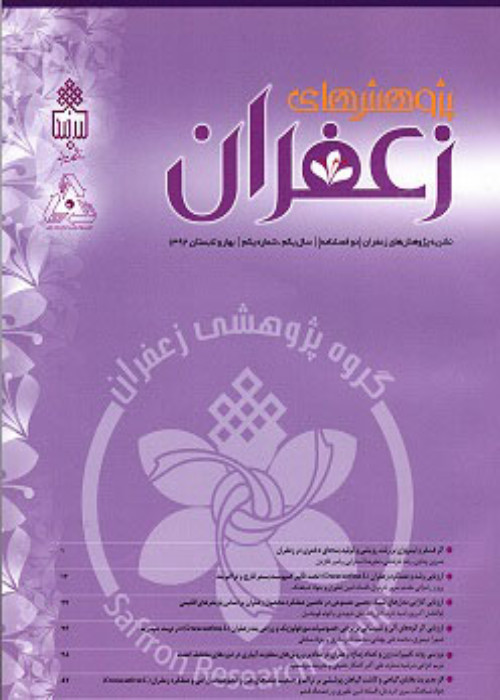Overview of Effective Saffron Compounds and Its Reactions on Neurodegenerative Diseases of Nervous System
Saffron is one of the most valuable plant species in the world and it’s medicinal and spice applications have a long history. It is referred to as “red gold,” due to the high market price attributable to hand-harvesting and low production volumes. Saffron, dried stigmas of Crocus sativus L. (Iridaceae), was traditionally used as food spice worldwide to provide color, taste, and odour in several food recipes. The contents of these active compounds varies from region to region. About 150 volatile and non-volatile compounds and about 50 main compounds have been identified in saffron. Water-soluble carotenoids specifically characterize crocin which identify color of the saffron. Picrocrocin and glycoside safranal are responsible for bitterness while safranal provides odor and aroma properties. Saffron is one of the medicinal plants that have many uses in traditional medicine, including antispasmodics, helping natural digestion, soothing gums, anti-inflammation, anti-cancer, anti-anxiety, anti-depression perspiration enhancer, stomach tonic, sexual stimulant, expectorant, pain killer, anti-running nose and premature menstruation can be mentioned.
articles about pharmacokinetics of saffron have been reviewed in this research. According to prevalent Neurodegenerative diseases, we selected eight illnesses in this paper including: Depression, Anxiety, Alzheimer’s Disease (AD), Parkinson’s Disease (PD), Post-Traumatic Stress Disorder (PTSD), Schizophrenia, Epilepsy, Stroke. Then, approximately all recent researches related to these diseases has been reviewed.
Saffron has the ability to scavenge free radicals because of its main constituents including carotenoids, safranal, picrocrocin, crocetin, crocin and quercetin. It has also the inhibitory effects on lipid peroxidation of membrane and, thus, protects cells from oxidative stress. Accordingly, several studies have been demonstrated that saffron has antioxidant activity and reduces oxidative damages in hippocampus, following improvement of spatial learning memory and muscle skeletal during ischemia. All of the investigations on the brain ischemia demonstrated that Saffron has neuroprotective roles. Saffron significantly reduces infarcted areas, which are induced by occlusion of the middle cerebral artery (MCA) in mice, by increased expression of gamma-glutamylcysteinyl synthase (gamma-GCS), the main enzyme for glutathione synthesis. Saffron therapy led to decreased inflammation and increased effects of hypothermia therapy in mice hypoxic ischemia-induced brain injury. Several animal model investigations showed that Saffron and its components have neuroprotective roles via inhibition of the production of free radicals and enhanced antioxidant activities in the ERK1/2 pathway-dependent manner. In Iranian traditional medicine, saffron has been used to cure obstructions inside brain to protect it from oxygen deprivation. Traditionally, the topical use of saffron in the boiling water is good for severe headaches and insomnia. Hopefully, some natural products have antidepressant effects like Saffron. Therefore, new drugs developed from extracts of natural products, especially those that have been shown to have low side effects in the treatment of depression, are becoming increasingly desirable. Antidepressants mainly work by increasing the availability of serotonin and certain other neurotransmitters, thereby reducing depressive symptoms. Depression and anxiety are two frequent and challenging comorbidities of AD. Studies have shown that patients with severe AD were more likely to have depression. Moreover, depression and anxiety could accelerate the progression, and increase the mortality of AD patients. Patients are likely to benefit from saffron because of its antidepressant and anti-anxious effects. Furthermore, Saffron has anti-inflammatory effects because it includes flavonoids, tannins, saponins, and crocins.
Saffron has four biological active compounds: crocin, crocetin, picrocrocin and safranal. These four compounds are responsible for the high value of the medicinal and nutritional effects of saffron. In addition, saffron contains two essential vitamins: riboflavin (vitamin B2) and thiamine (vitamin B1). In this study, an overview on recent scientific articles on the effective roles of saffron and its compounds in the treatment of neurological diseases such as Alzheimer’s disease, Parkinson’s disease, anxiety, epilepsy, stroke, etc. has been done.
- حق عضویت دریافتی صرف حمایت از نشریات عضو و نگهداری، تکمیل و توسعه مگیران میشود.
- پرداخت حق اشتراک و دانلود مقالات اجازه بازنشر آن در سایر رسانههای چاپی و دیجیتال را به کاربر نمیدهد.


